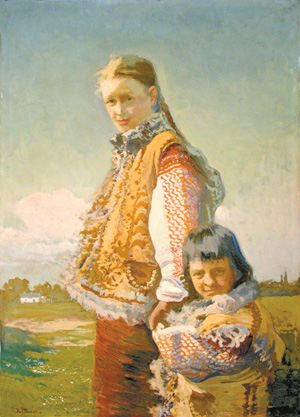Leopolitan impressionism
Ivan Trush’s works mark a renaissance in Galician painting
Lviv – Ivan Trush was a Ukrainian impressionist painter with a particular gift for landscapes and portraits, as well as an art critic and organizer of artistic life in Galicia. 2009 marked the 140th anniversary of the artist’s birth. Lviv’s College of Decorative and Applied Arts has been named after Trush. The artist’s oeuvre comprises over 6,000 works, mainly landscapes and portraits. Researchers assert that there are also several thousand counterfeits, which started to emerge when Trush was still alive. Sometimes he himself saw falsified works in salons and demanded that they were removed from sale.
Trush’s father was the first person to influence the formation of the future artist’s talent. He worked as a simple tailor, but, according to Trush, the clothes, “sewn by his father did not spoil the figure, and the decorations were rhythmically placed.” After graduating from elementary school, Trush studied in the Brody Gymnasium. As a student, he had to earn a living, so he painted small portraits on commission and took up tutorship. It was back in that time that he showed his talent for painting and was known for his remarkable knowledge of antique and European literature. While studying at the Krakow School of Arts (1891-97) he was awarded with silver and bronze medals for academic setting and landscapes. Trush combined his studies in Krakow with lectures in Vienna and Munich. It was in Krakow that he befriended Vasyl Stefanyk.
After graduating from the Krakow Academy in 1897 Trush moved to Lviv and became engaged in the public and artistic life of the city. Two years later the artist’s private exhibit was launched — it consisted of 38 canvases, landscapes and portraits — and in several weeks all of his works were sold out.
Trush also had close ties with the then Lviv and Kyiv intelligentsia, which is no surprise, as the artist supported the revival of the national culture. In 1898 he entered, together with the initiator of the first union of western Ukrainian artists, into the Association for the Development of Ruthenian Art. Later he organized the first All-Ukrainian Art Exhibit in Lviv. The artist communicated with Ivan Franko, created works for the Taras Shevchenko Scholarly Society. Trush painted portraits of various Ukrainian figures — Antonovych, Konysky, Zhytetsky, Lysenko, Nechui-Levytsky — on the order of the Shevchenko Society. Enchanted with Kyiv, Trush created a series of studies: The Volodymyr Hill, Saint Sophia Cathedral, St. Andrew’s Church, St. Michael Cathedral, A Monument to Bohdan Khmelnytsky, Dnipro near Kyiv. At his own initiative he painted Lesia Ukrainka’s portrait. The poetess sat for her portrait two hours each day. Lesia Ukrainka introduced Trush to Mykhailo Drahomanov’s family. The artist fell in love with Drahomanov’s daughter Ariadna, who later became his wife. Incidentally, their son Myron Trush was in Poland’s combined archery team and won the world championship.
Knowing Trush as an artist, we pay less attention to his activity as a sculptor, publicist, and literary critic. The artist contributed to Literaturny visnyk, and founded the magazines Buduchnist and Artystychny visnyk. As a versatile personality, he was fond of photography, and read and traveled much. Incidentally, a preparation for the retrospective photo exhibit that has a direct connection to the artist is underway at the Sheptytsky National Museum based in Lviv.
“In fact it is not an easy thing to define in what direction Ivan Trush was working,” the deputy head of the Sheptytsky Museum for scholarly work Oksana Bila explained, “Of course, we consider him to be an impressionist, above all neo-impressionist. This is connected with the education he obtained at the Krakow Academy, where he was taught by such famed masters as Leon Wyczolkowski and Jan Stanislawski. This is reflected in his creative work: in the coloring, use of specific lighting, which made his works romantic and mysterious. But it is impossible to call him a full follower of impressionism, which emerged in France, as after graduating from the Krakow Academy, he was shaped as an artist in Galicia, so he introduced his own changes and manner into this direction. We can see this in many of his works. Trush’s works are distinguished by their composition and lighting color, which give a specific allure to his works, and which is not found in the works by other Ukrainian artists. His specific coloring underwent changes over three decades. These changes were prompted by the artist’s travels. Trush managed to bring his innovative views into Ukrainian art, in which he raised new problems, united a circle of artists around himself — they followed their teacher in turning to the landscapes of their native land, everyday social problems, and showing the brightest ethnographic attributes typical of the Hutsul land.”






